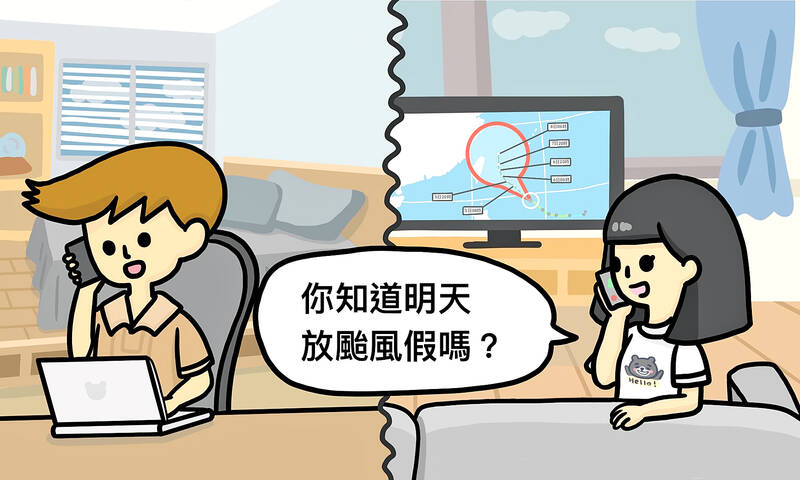對話 Dialogue
小實:馬克,你知道明天放颱風假嗎?
Xiǎoshí: Mǎkè, nǐ zhīdào míngtiān fàng táifēng jià ma?

馬克:不知道,你收到了學校的通知嗎?
Mǎkè: Bù zhīdào, nǐ shōudào le xuéxiào de tōngzhī ma?
小實:不是耶,是電視新聞播報的最新消息。
Xiǎoshí: Búshì ye, shì diànshì xīnwén bòbào de zuìxīn xiāoxí.
馬克:為什麼要放颱風假?我看現在的天氣還不錯啊!
Mǎkè: Wèishénme yào fàng táifēng jià? Wǒ kàn xiànzài de tiānqì hái búcuò a!
小實:肯定是氣象台預計明天的風雨不適合出門才放假的。
Xiǎoshí: Kěndìng shì qìxiàngtái yùjì míngtiān de fēngyǔ búshìhé chūmén cái fàngjià de.
馬克:這樣的話,我們應該準備什麼?
Mǎkè: Zhèyàng de huà, wǒmen yīnggāi zhǔnbèi shénme?
小實:我覺得今晚先準備一些食物,明天就別出門了。
Xiǎoshí: Wǒ juéde jīn wǎn xiān zhǔnbèi yìxiē shíwù, míngtiān jiù bié chūmén le.
馬克:好的,那我趕快先去超市買些東西!
Mǎkè: Hǎo de, nà wǒ gǎnkuài xiān qù chāoshì mǎi xiē dōngxi!
小實:好,注意安全喔!後天見。
Xiǎoshí: Hǎo, zhùyì ānquán ō! Hòutiān jiàn.
翻譯 Translation
Xiaoshi: Mark, did you know that a typhoon day off has been announced for tomorrow?
Mark: No, I didn’t. Did you receive the notification from the school?
Xiaoshi: No, it was the latest news on TV.
Mark: Why would they declare a day off? The weather seems fine right now!
Xiaoshi: I’m sure the meteorological department must have forecast that tomorrow’s weather is not suitable for going out.
Mark: In that case, what should we prepare?
Xiaoshi: I think we should prepare some food tonight and avoid going out tomorrow.
Mark: Alright, I’ll pop out to the supermarket to buy some things!
Xiaoshi: OK, stay safe! See you the day after tomorrow.
單字片語 Vocabulary
1. 颱風 (táifēng) typhoon
2. 通知 (tōngzhī) to notify
3. 新聞 (xīnwén) news
4. 播報 (bòbào) broadcast
5. 消息 (xiāoxí) news/ information
6. 肯定 (kěndìng) affirm, be sure
7. 預計 (yùjì) to forecast
8. 適合 (shìhé) to be suitable
9. 食物 (shíwù) food
10. 安全 (ānquán) safety
教材音檔 Audio Files
教材影片 Video Files:
https://www.instagram.com/celc.nou_tw/guide/_/17999106352646292/
實踐大學華語中心提供
By Shih Chien University Chinese Language Center: https://chineseusc.com/

A: According to reporter Joon Lee’s analysis, what are other reasons why the Los Angeles Dodgers made back baseball superstar Shohei Ohtani’s huge contract so quickly? B: Second, a lot of Japanese and global enterprises are eager to benefit from the “Ohtani effect”. . . A: That’s sure to increase the Dodgers’ bargaining chips in negotiations. B: Lastly, all this media coverage is elevating the Dodgers’ brand to a new level, boosting the value of the franchise. A: I can’t wait to see a battle between Ohtani and “Team Taiwan” at the 2026 World Baseball Classic. A: 根據記者Joon Lee的分析,洛杉磯道奇隊和球星大谷翔平的巨約快速回本還有哪些原因? B: 第二、無數日本和全球企業都想和這股「大谷效應」沾上邊……。 A: 這也增加了道奇在各種商業談判中的籌碼吧。 B: 第三、媒體報導更將道奇的品牌形象推升至全新的高度,使該隊價值水漲船高。 A: 真期待在2026年「世界棒球經典賽」,看到大谷和台灣隊的經典對決! (By Eddy

The subject of placebos has been fascinating scientists and medical professionals for decades. The word placebo comes from Latin and means “I shall please.” The concept of the placebo effect refers to the phenomenon in which treatments or procedures produce positive outcomes merely because individuals believe they will work. __1__ During medicine trials, researchers often include a “placebo group” as a control to measure the true efficacy of the medication being tested. While one group receives actual drugs, the placebo group is given an inert substance, such as a sugar pill. To ensure unbiased results, participants in the placebo

A: Major League Baseball’s 2025 World Series took place last week. The games between the Los Angeles Dodgers and Toronto Blue Jays were so exciting. B: As the highest-paid baseball player in the world, Shohei Ohtani of the Dodgers was an incandescant superstar. A: The Dodgers signed a record-breaking 10-year, US$700 million contract with Ohtani in 2023. As former ESPN reporter Joon Lee analyzed, the team quickly made back all the investment in the player’s first season. B: Wow, how is that possible? A: Firstly, tourism from Japan to Los Angeles has surged by 90 percent since Ohtani signed the deal, with the

1. 他們搭船渡河。 ˇ They crossed the river by boat. χ They crossed the river by the boat. 註︰ 表示交通方式時,交通工具前不加冠詞,如 by car、by train、by bus、by plane、by ship 等。若加了冠詞,則變成特指,意思是「他們搭上了正談論的那班船」,而不是泛指搭船這種交通方式。 2. 他們不再相信社會主 ˇ They no longer believe in socialism. χ They no longer believe in the socialism. 註︰ socialism、capitalism 等以 -ism 結尾的抽象名詞前不加冠詞。 3. 王博士演講介紹量子力學的基本知識。 ˇ Dr. Wang gave a lecture on the basics of quantum mechanics. χ Dr. Wang gave a lecture on the basics of the quantum mechanics. 註︰ 「量子力學」作為一種科目,不需加定冠詞。其他如 political science、Chinese literature、English history 等也是如此。 4. 南方人喜歡吃米,不太吃饅頭。 ˇ The southerners prefer rice to steamed bread. χ The southerners prefer the rice to the steamed bread. 註︰ rice、flour 等物質名稱前面不加冠詞。 5. 他因該戰役的功績晉升為上校。 ˇ He was promoted to the rank of colonel because